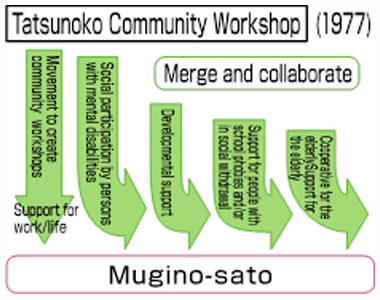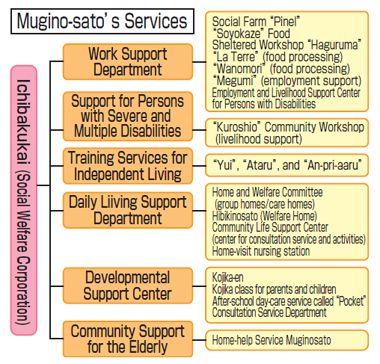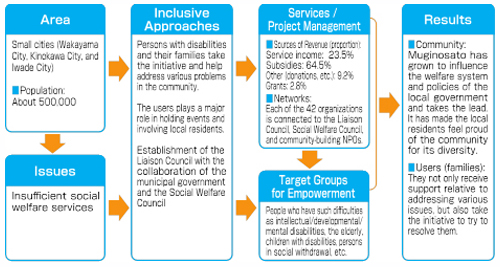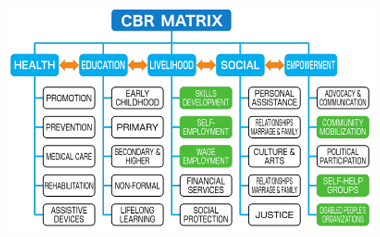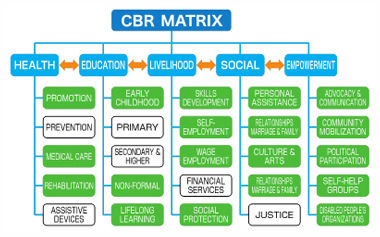Community-Based Inclusive Development
CBID Good Practices
“Mugino-sato” of “Ichibakukai” (Social Welfare Corporation)
(Wakayama City, Wakayama Prefecture)
Key Words Community Issues, Multiple Approaches
Keeping in mind “hottokeyan”―meaning, we cannot leave community issues unresolved, Mugino-sato and its activities have expanded by carrying on a movement trying to meet the needs of special people having problems in the community. Community residents, target users, Mugino-sato staff, and the municipal government have collaborated to try to create a community in which the residents’ desire to live a healthy life until the end is fulfilled in the very same community in which they were born and raised. The main objectives of Mugino-sato are: Early support and intervention for the children whose disabilities were detected early at a very young age; empowerment of the parents of such children; after-school support for the school children until they reach 15 years old; and encouraging persons with mental disabilities and the people who have graduated from special needs education schools to create their own places to live and work.
◆Background
One movement has arisen from the merger of the five (5) different movements:
- Community workshop movement, which started as a movement to address the issue of the need to guarantee education rights and places to work after students graduate from special needs education schools.
- A movement to help persons with mental disabilities return to society by improving their situation in the community because many such persons often have no choice but to stay in a mental hospital since there are no other places for them in the community.
- Developmental support movement for small children with disabilities, based on the concept of the national mandatory health checkup system, which guarantees child developmental support.
- Provision of facilities for people with school phobias and/or social withdrawal.
- Movement to set up a Senior Citizens’ Cooperative in the community to support the elderly with disabilities and by addressing their issues.
◆Service Outline
Originally an informal community workshop, Mugino-sato has evolved into a comprehensive rehabilitation center offering various services for persons/children with disabilities, people with school phobias and/or in social withdrawal, and the elderly.
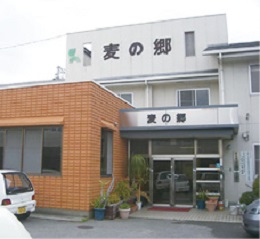
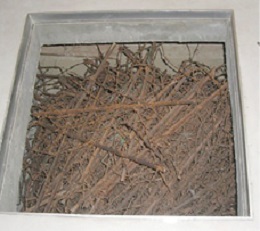
These are iron bars retrieved from a demolished mental hospital in Wakayama Prefecture. This is a powerful reminder of people’s determination to become socially independent by cutting the chains themselves.
Basic Data
●Area of coverage: Wakayama City, Kinokawa City, and Iwade City (Local cities)
●Population: About 500,000 in the area of coverage
●Issues: The basis for employment transitional support program, group homes, and care homes are still insufficient and require further improvement. Programs that provide home-based care services for children with disabilities are increasing, but the number of short stay programs, is still not enough. More approaches to medical institutions are also necessary to convince them to involve in projects that offer services to children needing medical care.
■Year of Establishment
Tatsunoko Community Workshop was created in 1977, and Ichibakukai (a social welfare corporation) began in 1989.
■Contents of Services
●Objectives: To meet the needs of the people, not only persons with disabilities, but anyone having problems in the community.
To fulfill the residents’ wish to live a healthy life until the end in the very same community in which they were born and raised.
●Purpose of Services and Target Groups: the elderly, persons with physical disabilities, persons with mental disabilities, persons with intellectual disabilities, children with disabilities, persons with developmental disabilities, young people with school phobias and/or in social withdrawal, persons with unique faces, and other people in the minority
●Stakeholders: Community residents; persons with disabilities and their families; staff providing welfare services; government officers in charge
●Main Source of Revenue: Payment (under the Comprehensive Welfare Law); donations; and income from services
●What We Have Implemented So Fa: In 1977, Tatsunoko Community Workshop was opened from the earnest desire of the teachers of hearing impaired students who need places to work in after graduating from special education school. In 1987, another community workshop for persons with mental disabilities, Ikoino-ie, was set up to meet their growing need for places to work. In the same year, Kojika-en also started to provide “security for development” for pre-school children by giving them early intervention and support. Since 2004, we have been providing after-school day-care services for school children with disabilities so they can have a place--that is neither home nor school--to play. At present we are managing twelve (12) community workshops, one (1) employment・daily living support center, six (6) group/care homes, four (4) daily living support centers, two (2) support centers for the elderly with nursing stations, and three (3) facilities for children with disabilities. In addition, there are six (6) service providers closely collaborating with us, which have, not only cpmminity workshops for persons with disabilities, but support centers as well for people in social withdrawal and multipurpose spaces for senior citizens. We also have a research center, consultation office, training center, accommodation, and various other facilities and services providers working with us. Altogether, about 200 staff members are engaged in “trouble shooting” the community’s wide range of problems.
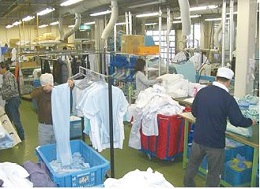
Laundry work
Mainly washing white coats from the contracted hospitals.
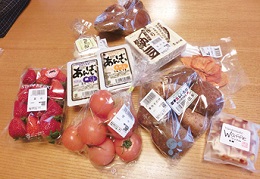
Products produced at Muginosato. By aiming at business diversification (we are now in our 6th industry), Muginosato has broadened its market in the community.
■Special Festures
■Making the community a better place to live in
Those movements initially began by asking for “places” and services which persons with disabilities and their families felt were badly needed in the community, and since then their range of activities to meet the needs of the times and society have broadened. This is why the activities of Muginosato are not limited to a particular area or specialized field, but cover many areas indicated in the CBR Matrix. Our range of activities are not limited to persons with disability, but by utilizing the experiences in support of persons with disabilities, the elderly and persons in social withdrawal, we have been able to offer multiple services to enable people to live in their community in spite of their “challenges”.
For instance, we have created and managed Youikuen to provide educational opportunities for children with disabilities, community workshops and a “Welfare Factory” to increase employment opportunities for persons with disabilities, a café opened at a renovated old house to be run by persons in social withdrawal, various cultural and arts activities are organized, and home-based long-term care services for physical and mental well-being, peer counseling services, group homes that enable community living, and places like Minnano-ie, were offered where elderly persons living alone can come and interact with others during the day.
■Expanding the Hottokeyan Network
While persons with disabilities and their families play the main role, the supporting roles played by the community and governments are indispensable for all Muginosato activities. Although it is a responsibility of the Muginosato secretariat to handle financial aspects, including the receiving of donations and subsidies, maintaining fixed assets, and allocating them to various services, the actual activities are managed not only by the Muginosato staff, but also by the service users themselves, like persons with disabilities and their families, as well as by community volunteers. request an organization in Tokyo to conduct a survey on after-school day care in Miyakojima City, and eventually started a children’s day-care service. These networks of contacts she established were fully utilized to start this long-term home-based care service. The foregoing is an example that proves that, no matter how far a community is from major cities, one is still able to access the latest information and competent personnel.
■Agent helping to revitalize the community
When making the film, “Please Give Us A Hometown,” which is the story of a couple with disabilities who met at Muginosato and got married, the people involved in community building contributed a great deal to the film in the town where the shooting took place. Later, a house that was over a hundred years old was donated and turned into a café for young people in social withdrawal. This café became a venue for arts and cultural activities where paintings are exhibited, band music by local high school students are performed, and music festivals take place. It is also being planned to start a community workshop specializing in arts by collaborating with other organizations, in the hope of creating a community rich in culture through the activities of persons with disabilities blessed with artistic talents. The community events that take place twice a year also create opportunities to interact with local residents. Through such interactions, the welfare facilities are no longer isolated from society, but regarded as an important factor in the revitalization of the community, along with other community residents and organizations.
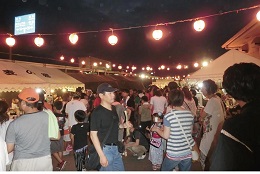
With community people at a festival… Muginosato’s stalls contribute to the festive mood, where local people, government officers and users work together.
■Advocacy and Partnership with the Local Government
From the beginning, we have always collaborated closely with the Wakayama Municipal Government and the local Social Welfare Council, and made efforts to raise awareness of the public about persons with disabilities by handing out leaflets to community residents and by holding meeting sessions. As a result, in 1987 the Wakayama Municipal Government hired the first mental health counselor (known today as a Mental Health/Welfare Counselor), ahead of any other municipalities in Wakayama Prefecture. In 1995 the Liaison Council of Mental Health and Welfare Services in Wakayama City was established, which made public-private partnership possible, and discussions and findings with the association have had a positive influence on the city’s mental health administration. Later, the proposal made jointly with a local residents’ association have led to Wakayama City’s new project of providing supporters in times of disasters. These examples demonstrate that the relationship between public and private sectors is not just that of giving and receiving instructions and subsidies, but that of contributing equally as partners, especially when it comes to creating livable environments friendly to community residents, including persons with disabilities.。
As of April 2012, in Wakayama City there were six (6) consultation support offices available where people could receive information and counseling in their community, regardless of types of disabilities. Since these consultation support service providers stay in close contact through their network, it helps to swiftly find those persons with disabilities who have been isolated from the community, and guarantee them some participation in community life.
◆How Things Changed
●How the community changed
Local residents’ associations and tenants’ associations highly regard persons with disabilities living at group homes as “trust-worthy people.” Some “rock ‘n’ roll” groups consist of persons with disabilities and the dance troupe of Muginosato often receives invitations to perform music or dances at different events and functions. Community residents take it for granted that their community has “Muginosato,” and even feel proud of the community for its diversity as it welcomes people from all walks of life to live here. Through study sessions, Muginosato can learn together with the city government, and the system allows Muginosato to play an indispensable role in Wakayama City’s welfare administration.
The foundation of Muginosato was created through the merging of different movements seeking services and facilities necessary for persons with disabilities, their families and all kinds of people having problems living in the community. Muginosato has played a role of bringing the people with problems to the attention of the community and to the government. While providing places for various activities, Muginosato has been a “catalyst” in initiating these community activities, and these have often been started and sustained through the initiatives of persons with problems themselves who needed to be involved in those same activities, as well as by the people in the community.
Various movements have been conducted by persons with disabilities and their families seeking facilities and services necessary for them to live in the community. The combination of these efforts led to the foundation of Muginosato. Muginosato plays a vital role of bringing persons with disabilities, who are marginalized, and persons with various problems to the attention of the community and the government. Activities are to be conducted mainly by persons with disabilities, the community and the government, while Muginosato brings them together, being a “catalyst” for meaningful activities to happen. The types of activities to be conducted very much depend on the needs of persons with disabilities and their community, and therefore activities can vary according to various areas of interest.
●How persons with disabilities have changed
Many persons with disabilities working at Muginosato have either officially or unofficially married and lived together with their partners. At the café made out of an old house, young people in social withdrawal are now actively participating in running the place. This café has attracted many elderly persons for events like karaoke, meeting friends, and just keeping their bodies in motion have helped them stay healthy.
■Current Issues and Way Forward
Muginosato has always aimed to overcome challenges that people faced in community life. It continues to explore and implement effective approaches to support persons with disabilities and other people with challenges living in the community to participate in society. For instance, the number of workplaces can be increased by diversifying local industries. By creating places to go and enjoy local culture, and running the café to provide opportunities for interaction, it is hoped to involve more persons with/without disabilities, young persons in social withdrawal and other young people in creating community life together. It is necessary to create an intensive community support system in which a community where persons with mental disabilities can live in ease at all times; but it is not easy, considering the current connection with mental health/welfare administration. Due to the present system and social welfare policies, welfare workers are often forced to stay as part-timers and bear low wages, which deter young people from entering into this field. While this is the common challenge seen all over the country, Muginosato, too, is having difficulty hiring and retaining the staff needed to achieve its objectives.
■Analysis Using the CBR Matrix
◆Original Goals:
Tatsunoko Community Workshop to provide a place for people with disabilities to work was created with the efforts of families of people with disabilities. At the same time, efforts were made to raise awareness and understanding of the community residents about persons with disabilities.
◆Current Activities (Diversification of Services)
We continue to take a holistic approach in providing services to all kinds of people with problems, regardless of types of disabilities, and for all life stages.
This unique method of letting concerned community residents as well as persons with problems conduct activities themselves deserves some attention – for instance, community residents running places for the elderly, and a café being planned and managed by a group of young people in social withdrawal.

